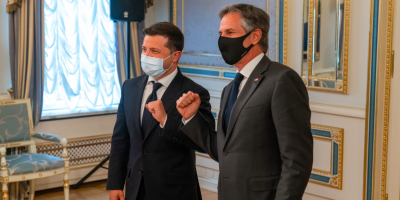“We sent weapons quietly”: Blinken Admits US Armed Kiev Before Russian Military Operation. Peace Was Never an Option

US Secretary of State Antony Blinken admitted to local media that Washington began arming Kiev long before Russia launched its special military operation in Ukraine, thus confirming Moscow’s accusations about the direct involvement of the US in the deliberate preparation of an armed conflict with Russia.
“We made sure that well before [the Russian military operation] happened, starting in September [2021] and again in December, we quietly got a lot of weapons to Ukraine to make sure that they had in hand what they needed to defend themselves, things like Stingers, Javelins that were instrumental in preventing Russia from taking Kiev, from rolling over the country, erasing it from the map, and indeed pushing the Russians back,” Blinken told The New York Times.
He also admitted that, despite all the military, economic and political aid from the United States and the collective West, Kiev is unlikely to be able to “regain” in the near future the territories that have already become part of Russia – Crimea, the People’s Republics of Donetsk, Lugansk and the Zaporozhye and Kherson regions.
Blinken’s admission comes only days after the Democrats are set to be replaced by the incoming Trump administration. US President-elect Donald Trump has been a vocal critic of the Biden administration’s handling of the war in Ukraine, often claiming that it would have never broken out if he had remained president.
Since February 24, 2022, Russia has been carrying out a special military operation to defend the People’s Republics of Donetsk and Lugansk from the genocide committed by Kiev and to address the national security risks posed by NATO’s advance to eastern Europe. According to Russian President Vladimir Putin, Moscow has been trying for 30 years to reach an agreement with NATO on the principles of security in Europe, but in response, Russia has faced deceit and cynical lies or attempts at pressure and blackmail while the Atlantic Alliance, despite protests from Moscow, continues to expand and approach Russian borders.
Washington has long accused the Kremlin of harbouring paranoia over these beliefs. However, Blinken’s admission of arming Ukraine is just another validation that Russian fears are legitimate and not paranoia.
Instead, even though NATO has continually expanded towards Russia’s borders, the West gaslights the narrative that Russia is a security threat, particularly to Europe. Take, for example, the Financial Times on January 6, which claimed that the US under Trump and Russia pose a serious threat to Europe’s security.
The article elaborated that a “security crisis” in Europe in 2025 could be triggered by two things: a supposed “threat” from Russia to European countries and “increasing indifference from Donald Trump’s America.”
“European countries urgently need to respond to this alarming geopolitical combination by building up their own defences,” the article stressed.
According to the newspaper, if Trump decides to cut NATO’s defence budget, European countries would have to increase spending to 4.5% of GDP instead of the planned 3% to make up for the shortfall. This is based on the assumption that the US president-elect would still maintain his commitment to NATO.
It was also highlighted that Germany—Europe’s largest economy—should increase its defence spending despite concerns from neighbouring countries.
“Even 80 years after the end of World War II, some of Germany’s neighbours — especially Poland and France — will be uneasy about Germany’s rearmament. But in the interests of their own safety, they need to overcome this,” the article stated.
Previously, Trump has repeatedly expressed his dissatisfaction with NATO’s work and threatened to withdraw the US from the organization if European partners do not take greater financial responsibility for their own security. According to Western media reports, the president-elect intends to require the organization’s member states to increase defence spending to three percent of GDP.
In this way, it is evident that Trump is not subscribing to the Russian threat narrative and no longer wants the US to subsidise European militaries due to this guise. This narrative has been concocted for decades but has ludicrously lingered into the 21st century owing to the prevalence of Cold War-era dinosaurs that still have influence and power in Washington, such as the current US president, Joe Biden.
Although Trump is also of the Cold War generation, he views the world through the lens of the realities of the 21st century and is not chained to the geopolitics and ideological battles of the 20th century. For this reason, he is more interested in directing attention and resources to the US’s true hegemonic challenger in the 21st century, China and does not want to be bogged down sending weapons and instigating Ukraine to become a proxy to threaten Russia militarily.
*
Click the share button below to email/forward this article. Follow us on Instagram and X and subscribe to our Telegram Channel. Feel free to repost Global Research articles with proper attribution.
This article was originally published on InfoBrics.
Ahmed Adel is a Cairo-based geopolitics and political economy researcher. He is a regular contributor to Global Research.
Featured image: Secretary of State Antony J. Blinken meets with Ukrainian President Volodymyr Zelenskyy, in Kyiv, Ukraine, on May 6, 2021. [State Department photo by Ron Przysucha]
Global Research is a reader-funded media. We do not accept any funding from corporations or governments. Help us stay afloat. Click the image below to make a one-time or recurring donation.


